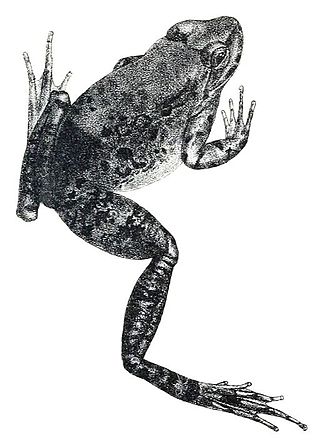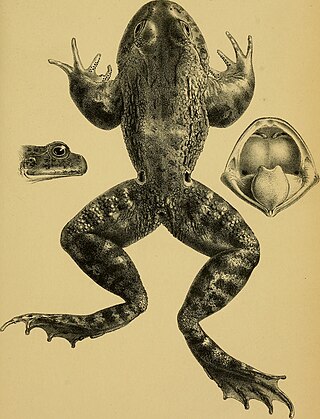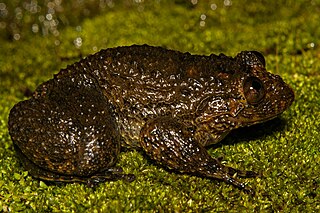
Microhyla chakrapanii is a species of frog in the family Microhylidae, the narrow-mouthed frogs. It is endemic to the Andaman Islands. It is also known as the Mayabunder rice frog, Chakrapani's narrow-mouthed frog, and bilateral banded frog. Although morphology suggests association with the Microhyla achatina group, molecular data places it in the Microhyla fissipes group, with Microhyla mymensinghensis as its closest relative.

Blaira ornata, known with common names ornate toad, Malabar torrent toad or black torrent toad, is a rare and endangered species of toad endemic to the Western Ghats. In 2009, this species along with A. rubigina was shifted from Ansonia to the genus Ghatophryne. The publication of the new genus however did not meet ICZN requirements and a new genus Blaira was created in 2021.
Microkayla wettsteini is a species of frog in the family Strabomantidae. It is endemic to Bolivia and only known from the region of Unduavi in the Unduavi Valley, Sud Yungas Province, La Paz Department. Common names Wettstein's Andes frog and LaPlaca's Andes frog have been coined for it. It is named for Otto von Wettstein, Austrian zoologist.
Nanorana quadranus is a species of frog in the family Dicroglossidae. It is endemic to central China. Its natural habitats are temperate forest and shrubland, with breeding taking place in small rivers. It is a common species believed to be declining. It is threatened by collection for food and also habitat loss.
Nanorana unculuanus is a species of frog in the family Dicroglossidae. It is endemic to central and southern Yunnan, China, although it is expected to have wider distribution than currently known, possibly extending into Vietnam. Its natural habitats are fast-flowing hill streams and riparian habitats in forests and grasslands, but also man-made habitats like roadside drainage ditches and ponds. It is a rare and secretive species that appears to be declining. It is currently threatened by collection for food and also by habitat loss.
Nanorana ventripunctata is a species of frog in the family Dicroglossidae. It is endemic to northwestern Yunnan, China. It inhabits lakes, pools and ponds in alpine areas, occurring near streams and rivers in open, high-elevation habitats. It breeds in still-water pools and ponds.

Nanorana blanfordii is a species of frog in the family Dicroglossidae. It is found in northeastern India, southern Tibet (China), and eastern Nepal, and likely in the adjacent western Bhutan. The specific name blanfordii honours William Thomas Blandford, a British geologist and zoologist.

Nanorana ercepeae is a species of frog in the family Dicroglossidae. It is endemic to western Nepal. Its type locality is Torrent Jiuli Gad in Bajhang district. This relatively rare frog is found in stream habitats in upland temperate rainforests. One specimen of P. ercepeae was recorded from the still-water habitats of Rara Lake in Rara National Park. It is threatened by habitat loss and degradation caused by small-scale agricultural development and wood extraction.

Nanorana feae is a species of frog in the family Dicroglossidae. It is found in Yunnan, China, and the Kachin Hills in Myanmar. The specific name feae honors Leonardo Fea, an Italian explorer, zoologist, and naturalist. This little-known species probably inhabits hill streams in forested areas.

Nanorana liebigii, also known as Sikkim paa frog, Liebig's paa frog, Liebig's frog, and spiny-armed frog, is a species of frog in the family Dicroglossidae. It is found in the Himalayas, specifically in Bhutan, southern Tibet (China), northern India, and Nepal. The specific name liebigii honours a certain "Dr von Liebig Jr.", likely referring to Justus von Liebig, German botanist and chemist.
Nanorana maculosa is a species of frog in the family Dicroglossidae. It is endemic to central Yunnan, China, where it occurs in Jingdong County and Shuangbai County. This rare frog inhabits forest streams. It is threatened primarily by collection for human consumption. It is currently protected by the Ailaoshan and Wuliangshan National Nature Reserves.
Nanorana medogensis is a species of frog in the family Dicroglossidae. It is endemic to Tibet, China, and only known from near its type locality in Mêdog County in southeastern Tibet, near the Indian border. It lives in forested streams, and is sometimes also found at the edges of pools and ponds.

Nanorana rarica is a frog species in the family Dicroglossidae. It is endemic to western Nepal. Its type locality is the eponymous Rara Lake located in the Rara National Park.
Nanorana yunnanensis, commonly known as Yunnan paa frog, Yunnan spiny frog, Bourret's paa frog or Bourret's frog, is a species of frog in the family Dicroglossidae. It is found in southwestern China, Vietnam, Myanmar, northern Thailand, and likely in the intervening Laos. Its natural habitats are small and large streams in montane forests, scrub vegetation and grasslands, and it has also been found in ditches. It is threatened primarily by collection for human consumption, but also by habitat loss caused by agricultural development and infrastructure development.
Cornufer macrosceles is a species of frog in the family Ceratobatrachidae. It is endemic to the island of New Britain, Papua New Guinea. It is only known from the Nakanai Mountains in the central part of the island. Only three specimens are known. Common name Ti wrinkled ground frog has been coined for the species.
Minervarya charlesdarwini is a species of frogs in the family Dicroglossidae. It is endemic to the Andaman Islands, India, and is known from the South Andaman Island, Long Island, and North Andaman Island.

The spinular night frog, also known as the spinular wrinkled frog, is a species of frog in the family Nyctibatrachidae, commonly known as the robust frogs. It was described in 2011 as one of 12 new species in its genus by the herpetologist Sathyabhama Das Biju and his colleagues. A large frog for its genus, it has an adult male snout–vent length of 52.9–66.2 mm (2.08–2.61 in). It has a brownish-grey back, a grey underside, dark brown limbs, and dark grey feet. When preserved in ethanol, it is black above with greyish-brown undersides. The species is endemic to the Western Ghats of India, where it is known from the states of Kerala and Tamil Nadu, where the specimens used to describe the species were originally collected. It is found under rocks in streams in forests. The species has not been assigned a conservation status by the IUCN.

Nyctibatrachus robinmoorei, also known as Robin Moore's night frog or the Tirunelveli wrinkled frog, is a species of frog in the family Nyctibatrachidae, commonly known as the robust frogs. It was described in 2017, along with six other species in its genus, by the herpetologist Sonali Garg and her colleagues. A small frog, it has an adult male snout–vent length of 12.2–13.4 mm (0.48–0.53 in). It is mainly reddish-brown, with a light grey underside, light orangish-brown bands running from the eyes to the middle of the back, light brown limbs, and darker brown hands and feet. When preserved in ethanol, it is mostly brown, with light greyish-white undersides and light greyish-brown limbs.

Nyctibatrachus radcliffei, also known as Radcliffe's night frog or the Thiashola wrinkled frog, is a species of frog in the robust frog family Nyctibatrachidae. It was described in 2017, along with six other species in its genus, by the herpetologist Sonali Garg and her colleagues. A medium-sized frog for its genus, it has an adult male snout–vent length of 32.8–38.3 mm (1.29–1.51 in). It is mainly reddish-brown, with a light flesh-red coloured underside, light brown limbs, and dark grey hands and feet. When preserved in ethanol, it is mostly dark grey, with grayish-white undersides.

Nyctibatrachus sabarimalai, also known as the Sabarimala night frog or Sabarimala wrinkled frog, is a species of frog in the family Nyctibatrachidae, commonly known as the robust frogs. It was described in 2017, along with six other species in its genus, by the herpetologist Sonali Garg and her colleagues. A small frog, it has an adult male snout–vent length of 12.3–13.2 mm (0.48–0.52 in). It is mainly brown, with a dark brown back, a greyish-white underside, light brown bands running from the eyes to the middle of the back, light brown limbs, and light grey hands and feet. When preserved in ethanol, it is mostly grey, with greyish-white undersides and light grey limbs.












